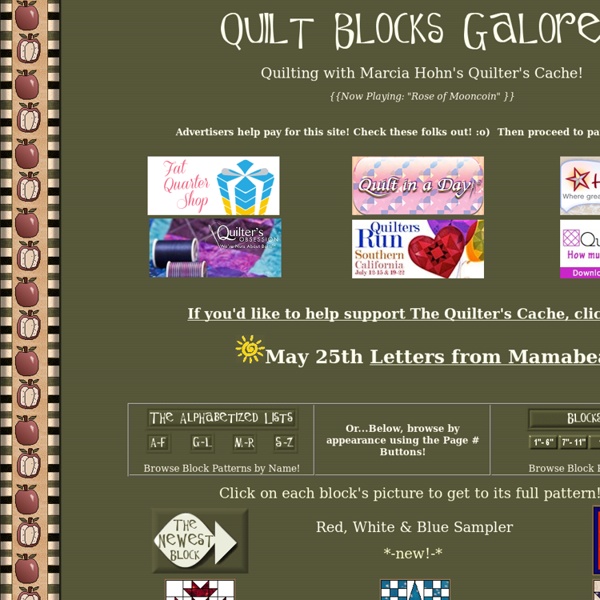



Ideas for Quilting Quilt in a Day - Quilt Patterns, Quilt Books, Rulers and Supplies by Eleanor Burns Free Quilt Patterns The Last Piece Take my Craftsy Class!Learn from me any time of the day or night by taking my classes, Big Techniques From Small Scraps, and NEW class Word Play at www.craftsy.com Sarah is available for teaching both within Australia and internationally. If you are interested having Sarah teach for you during any of her scheduled tours or at other times, please email sarah@sarahfielke.com for information. Upcoming Teaching Venues:* Tour of NZ - Cushla's Fabrics Devonport and Nelson, Cottage Flair Rotorua and The Apple Basket - May 2016.
Scrap Quilts - Free Quilt Patterns - Learn How to Make Quilts Red Pepper Quilts Quilt and more at Better Homes and Gardens Sew up creative projects with our step-by-step instructions and quilt patterns. Use these ideas for inspiration. Free Quilt Patterns for Bed-Size Quilts and ThrowsBHG.com / Crafts / Sewing / Free Quilt Patterns for Bed-Size Quilts and Throws Free Quilt Patterns for Bed-Size Quilts and Throws Curl up with one of these handmade bed-size quilts and quilted throws … Free Quilt Patterns for Small Quilts BHG.com / Crafts / Quilting / Free Quilt Patterns for Small Quilts Free Quilt Patterns for Small Quilts Try one of these small quilting projects to add quick style to your home. Use our step … Quilt Patterns We Love… Projects / Quilt Patterns We Love Quilt Patterns We Love We love quilts ! Here you will find a collection ..... Table Runner. Quilt Block Challenge… How Can You Help?
Quilt Patterns - Beginner patchwork quilt patterns and quilting lessons Trends and Traditions | Where Trendy meets Traditional Quilting, by Designer Heather Mulder Peterson of Anka's Treasures Mod Podge Mason Jars [ Close Privacy Policy ] Privacy Policy / Your California Privacy Rights Revised and posted as of March 4, 2013 Prime Publishing, LLC ("Company," "we" or "us") reserves the right to revise this Privacy Policy at any time simply by posting such revision, so we encourage you to review it periodically. In order to track any changes to this Privacy Policy, we will include a historical reference at the top of this document. This Privacy Policy will tell you, among other things: Your California privacy rights. ACKNOWLEDGEMENT/YOUR AGREEMENT Company websites are not intended for use by individuals under the age of 18 or those who are not legal residents of the United States. HOW DO WE COLLECT INFORMATION AND WHAT INFORMATION DO WE COLLECT? Distribution Partners Website operators that license our ad serving technology pass information to us so that we may serve advertisements to you. Website Registration Forms We collect information about you when you register on one of our websites.
How to Quilt: Scrap Quilts How to Quilt>Scrap Quilts Bonnie Hunter is a quilter who specializes in scrap quilts using fabric from thrift shops or donations from friends' closets. Recently she visited with us for our Eavesdrop on a Telephone Conversation, and the specific topic was how to choose the garments at a thrift shop that will make great fabric for a quilt. Here is a sampling of her answers: Penny: How do you know whether a particular garment would make a good fabric for a quilt? Bonnie: I look for garments the same way I look for fabric. If it says 100% cotton, then that’s the first thing I’ll look for. The next thing I check is how the fabric feels in my hand. I look for the same kinds of things when I look for articles of clothing to cut up for fabric. Penny: You don’t use polyester? Bonnie: No, I don’t. Men’s shirts, so far, have not incorporated spandex. Penny: How do you estimate how much fabric you’ll be able to get from a particular garment? Bonnie: The size of the garment will give you an idea.
myBearpaw